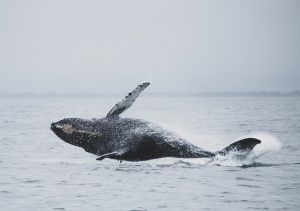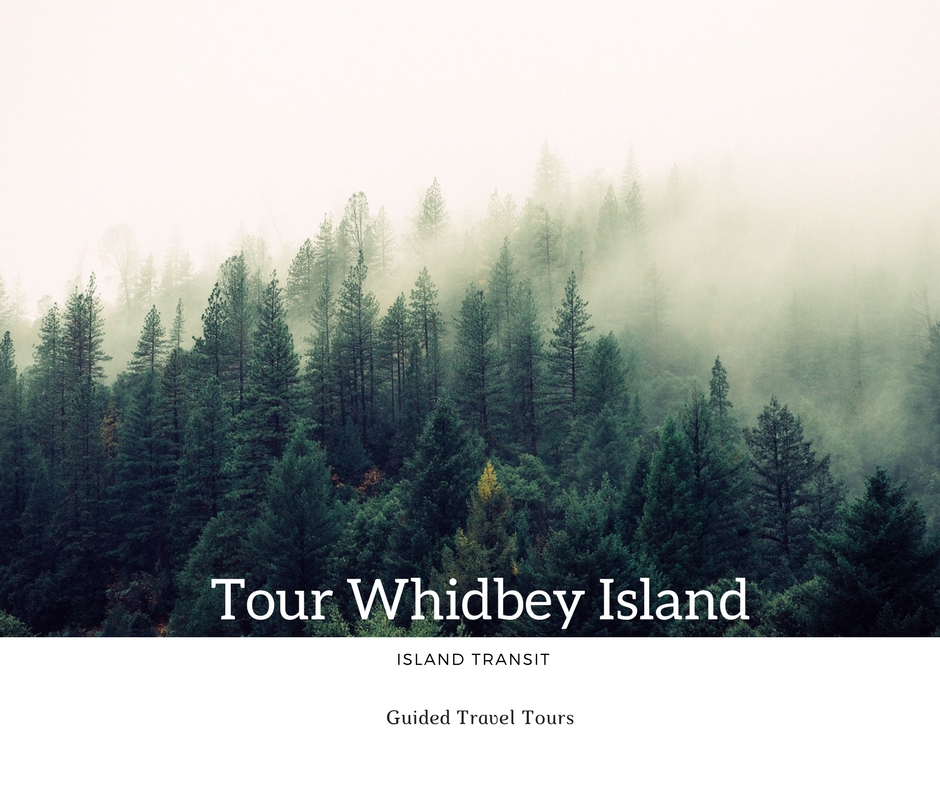Island Transit on Whidbey Island
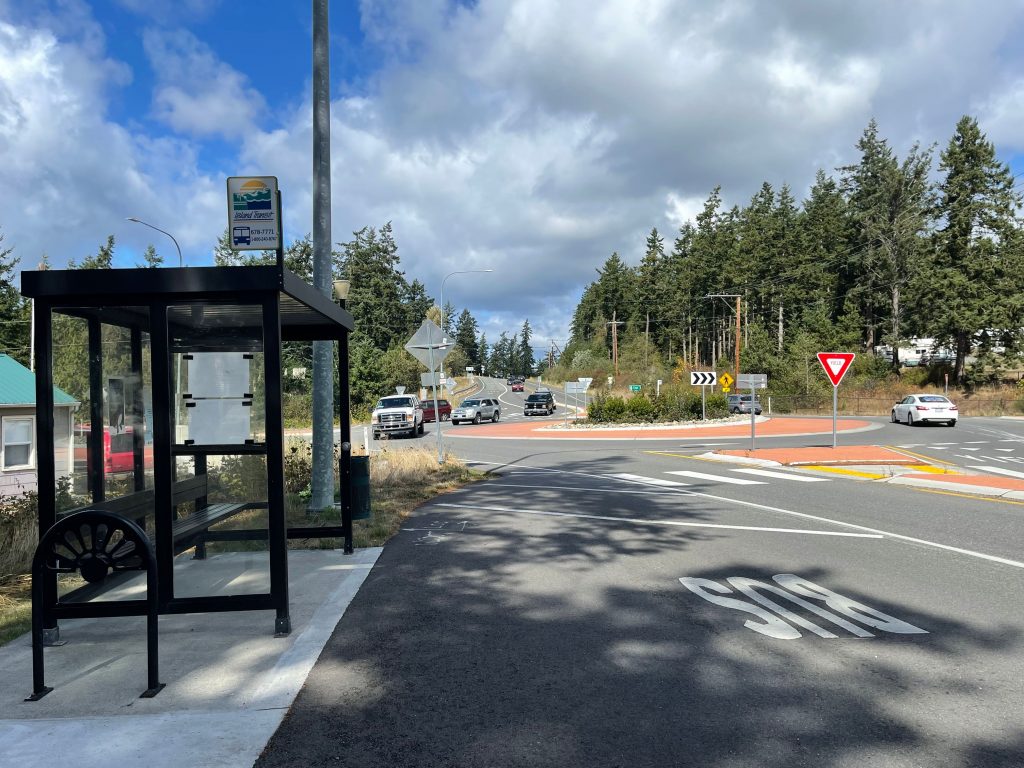
Island Transit is the public transportation system serving Whidbey Island, located in the Puget Sound region of Washington state. The system consists of fixed-route buses and paratransit vans, as well as additional programs such as vanpools and bike locker rentals.
Island Transit began on December 1, 1987 as a response to the increasing traffic congestion and lack of transportation options on Whidbey Island. Today, the system serves a population of approximately 73,000 people, covering a service area of approximately 400 square miles. The buses pick up passengers from bus stops like the Northgate Terrace bus stop pictured above throughout all of Whidbey Island.
In addition to its fixed-route buses, Island Transit also operates a paratransit service for individuals with disabilities who are unable to use the fixed-route buses. The paratransit vans offer door-to-door service and can be reserved by calling Island Transit in advance.
Island Transit’s vanpool program is a convenient and cost-effective alternative for commuters who travel long distances or have irregular work schedules. Participants in the program share the cost of gas and vehicle maintenance and can save money on the cost of driving alone.
The bike locker rental program allows riders to securely store their bike at a convenient location and use it to complete the first or last leg of their commute. The lockers are located at select bus stops and can be rented on a monthly basis (check out prices and apply here) in addition to public use lockers that are on a first come first served basis.
In recent years, Island Transit has made efforts to increase sustainability and reduce its environmental impact. Learn more about their initiatives here. As a result, hybrid buses have been added to its fleet all while keeping Island Transit buses fare-free.
Overall, Island Transit plays a vital role in the transportation needs of the residents and visitors of Whidbey Island. The convenient and reliable services, as well as its vanpool and bike locker rental programs, make it a valuable asset to the community.
If you have further questions or are interested in learning more about living on Whidbey Island please do not hesitate to connect with us. Contact us here.
View this post on Instagram
We are NOT in a Housing Bubble: Here’s Why!
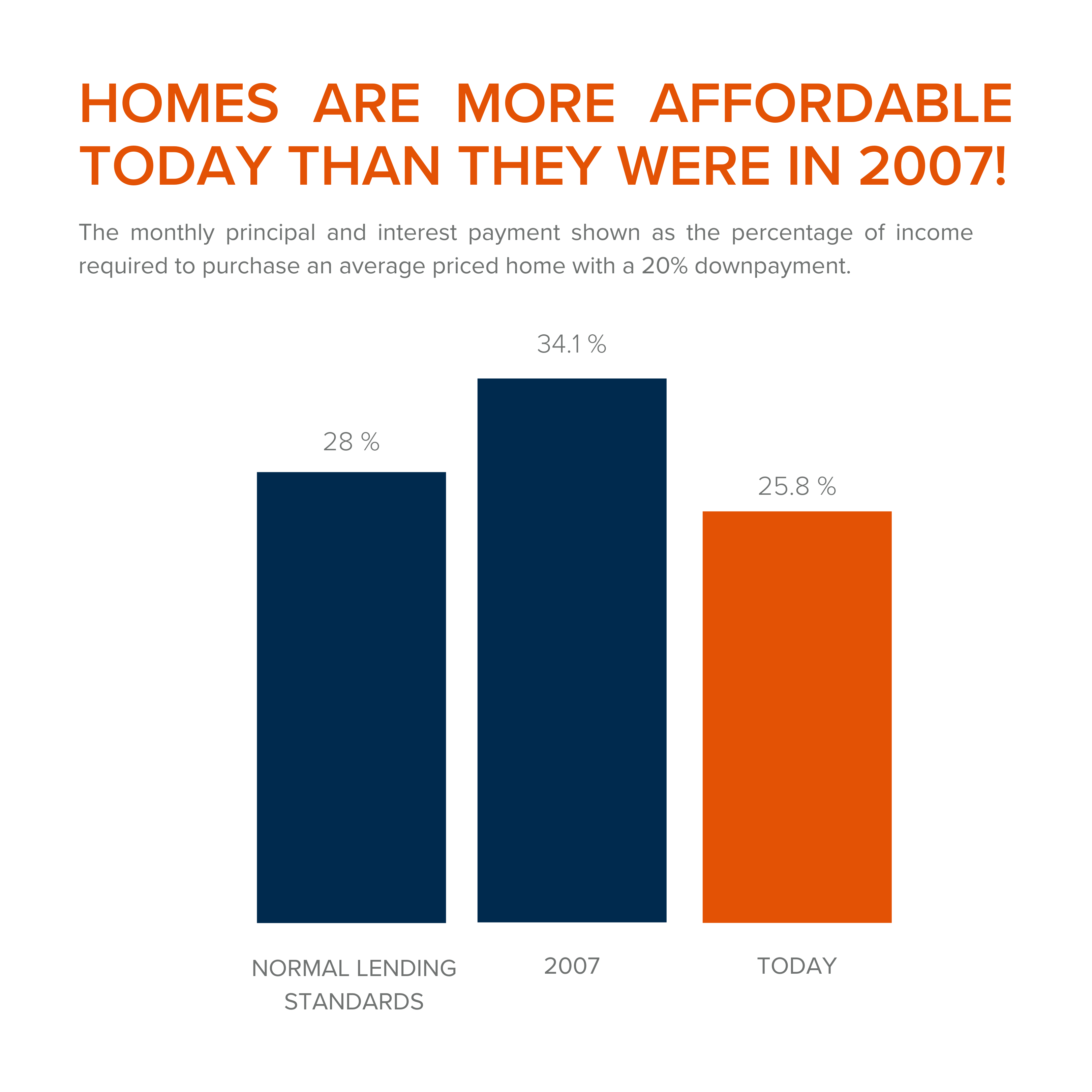
Home buyers are beginning to believe we are heading into a housing bubble. It is easy to acknowledge this premonition, as year-after-year home price appreciation has continued to remain in the double digits.
However, we are here to put your mind at ease as this market is very different than it was during the housing crash 15 years ago. Follow along as we explain four fundamental reasons why today's market is nothing like the market was back then.
1. Houses Are Affordable Unlike During the Housing Boom
To understand this, one must understand the affordability formula. The affordability formula consists of three parts: the price of the home, wages earned by the purchaser, and the mortgage rate available at the time of purchase. Conventional lending standards suggest a purchaser should spend no more than 28% of their gross income on their mortgage payment.
Fifteen years ago, prices were high, wages were low, and mortgage rates were over 6%. While today's home prices are high, wages have increased significantly, and despite the latest spike, mortgage rates are still well below 6%. This means that todays average buyer spends less of their monthly income toward their mortgage payment than buyers did back then.
In the latest Affordability Report by ATTOM Data, Chief Product Officer Todd Teta speaks to this stating, "The average wage earner can still afford the typical home across the U.S., but the financial comfort zone continues shrinking as home prices keep soaring and mortgage rates tick upward."
Undeniably, affordability is not as strong as it was last year, but it is significantly better than it was during the boom. The graph below demonstrates that difference:
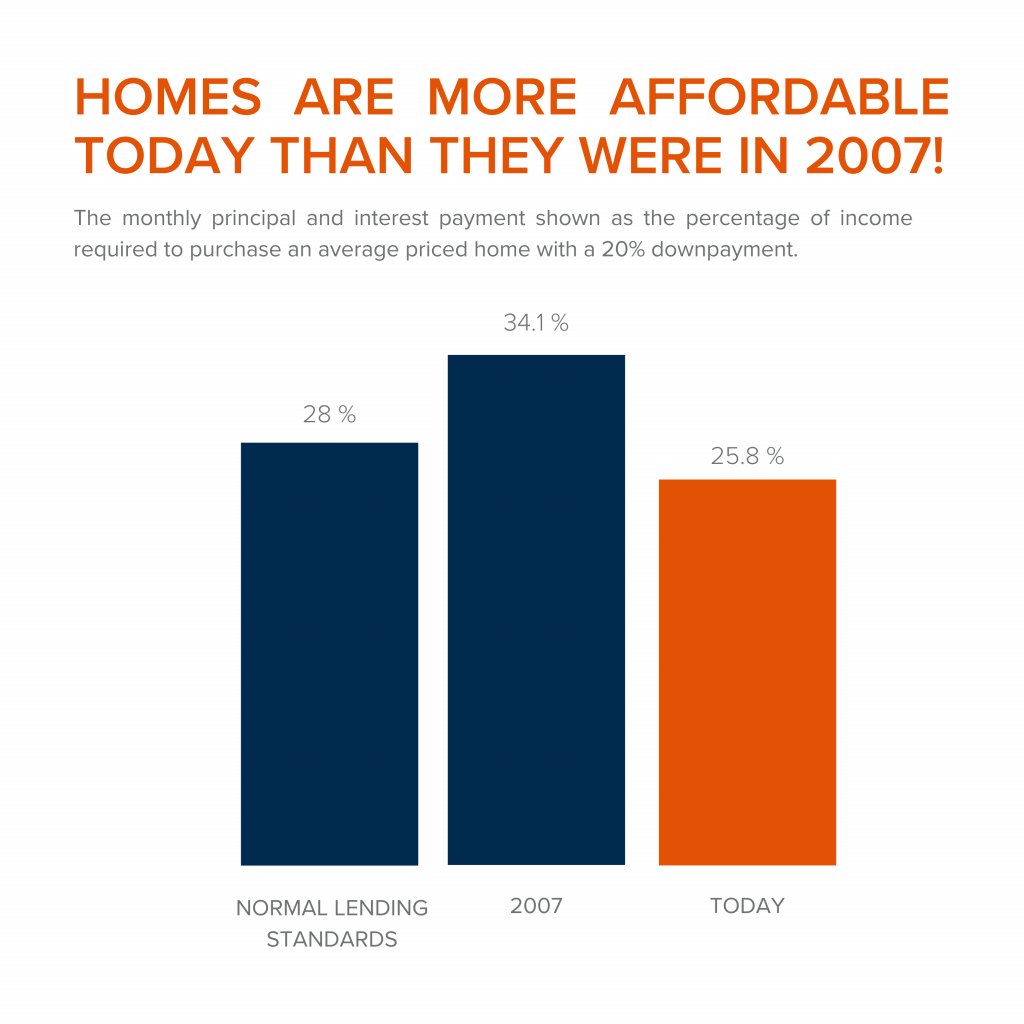
How did so many homes sell during the housing boom with such prohibitive costs?
2. Mortgage Standards Were Much More Relaxed During the Boom
Getting approved for a mortgage loan was significantly more attainable during the housing bubble than it is today. According to credit.org, a credit score between 550-619 is considered poor. They define those with a score below 620, by stating that, "Credit agencies consider consumers with credit delinquencies, account rejections, and little credit history as subprime borrowers due to their high credit risk."
While buyers can still qualify for a mortgage with a credit score within that range they are considered riskier borrowers. If you are in that range, read our How Long Does it Take to Save for a Down Payment article here. Below is a graph illustrating the mortgage volume issued to buyers with a credit score less than 620 during the housing boom, in compression to the following 14 years.
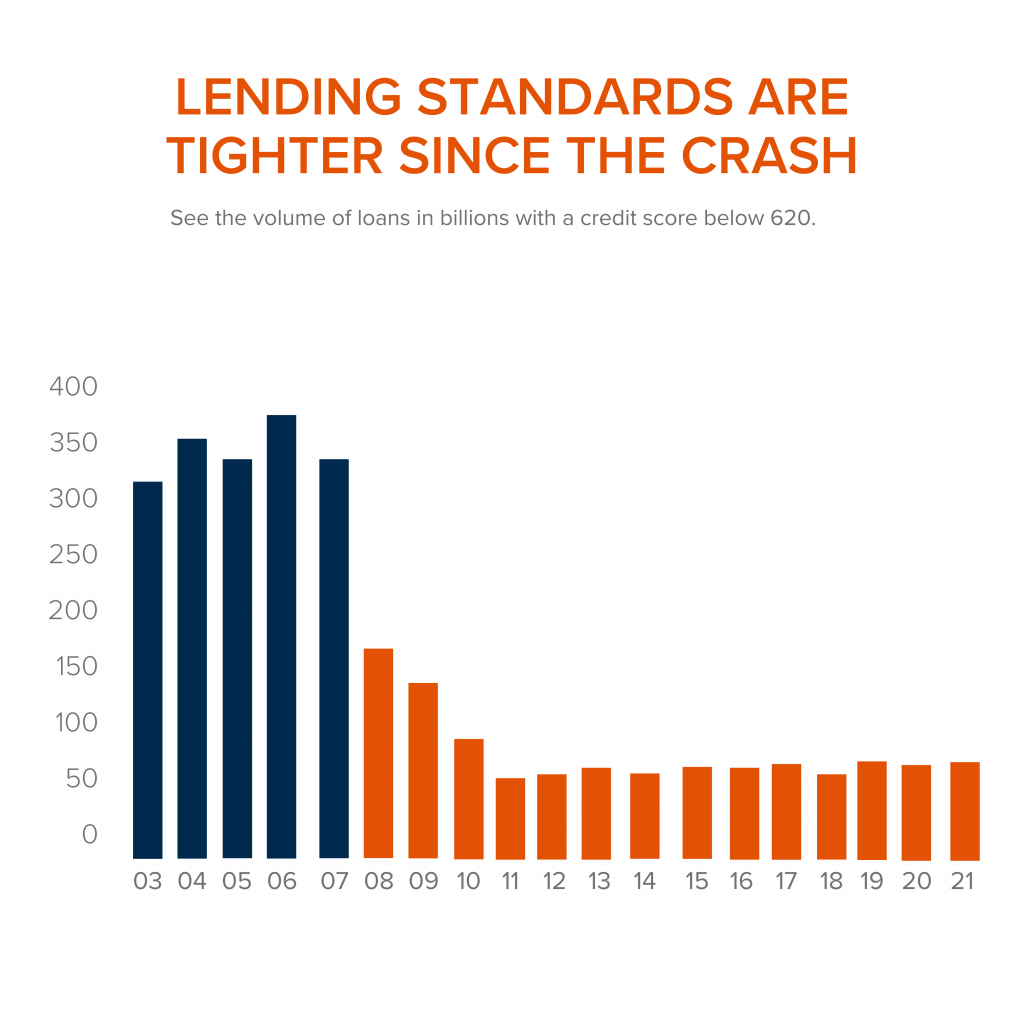
Mortgage standards are significantly different than they were last time. Buyers that obtained mortgages during the past decade are better qualified for the loans. Lets look at what that means moving forward.
3. Foreclosure Are Completely Different Than They Were During The Crash
The most obvious difference is the number of homeowners that were facing foreclosure after the housing bubble burst. The Federal Reserve issues a report showing the number of consumers with a new foreclosure notice. Here are the numbers during the crash compared to today:
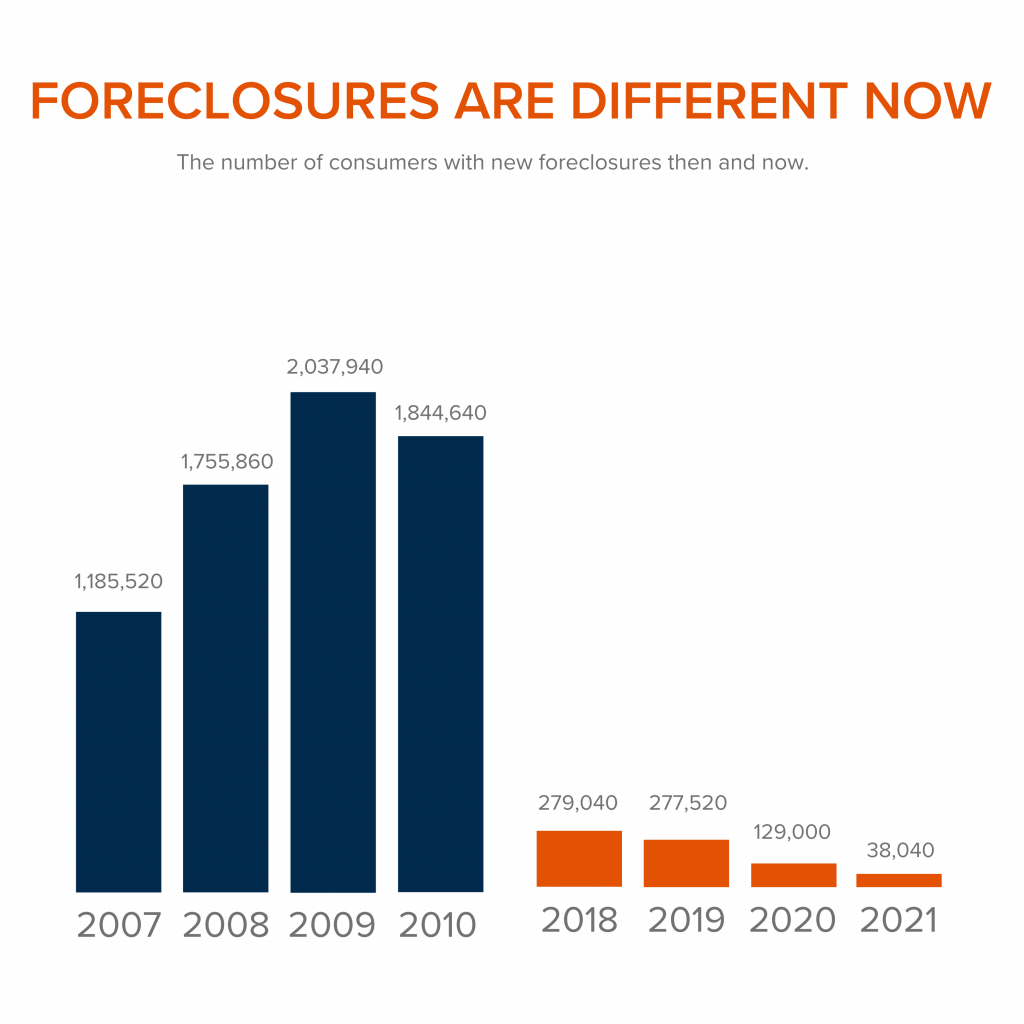
Undoubtedly the 2020 and 2021 numbers are impacted by the forbearance program, which was created to help homeowners facing uncertainty during the pandemic. Keep in mind, there are less than 800,000 homeowners remaining in the program today, and the majority of those will be able to work out a repayment plan with their banks.
Rick Sharga, Executive Vice President of RealtyTrac, explains, "The fact that foreclosure starts declined despite hundreds of thousands of borrowers exiting the CARES Act mortgage forbearance program over the last few months is very encouraging. It suggests that the ‘forbearance equals foreclosure' narrative was incorrect."
Why are there significantly less foreclosures seen today? Well, homeowners today are equity rich. They are not tapped out.
During the build-up to the housing bubble, some homeowners were using their homes as personal ATM machines. We saw a plethora of people withdrawing their equity the moment it was built up. When home values began to fall, many homeowners found themselves in a negative equity situation where the amount they owed on their mortgage had surpassed the value of their home. Many were faced with the decision of walking away from their homes. When that happened it led to a rash of distressed property listings (foreclosures and short sales), which sold at huge discounts, thus lowering the value of comparable homes in the area.
Homeowners, have since learned their lessons. Prices have risen nicely over the last few years, leading to over 40% of homes in the country having more than 50% equity. But owners have not been tapping into it like they had previously, as indicated by the fact that national tappable equity has increased to a record $9.9 trillion. With the average home equity now standing at $300,000. What happened last time will not happen today.
As the latest Homeowner Equity Insights report from CoreLogic explains, "Not only have equity gains helped homeowners more seamlessly transition out of forbearance and avoid a distressed sale, but they've also enabled many to continue building their wealth."
There will be nowhere near the same number of foreclosures as we seen during the crash. What does that mean for the housing market today?
4. There is Not a Surplus of Homes on the Market – We Have a Shortage
The supply of inventory needed to sustain a normal real estate market is approximately six months. Anything more than that is an overabundance and will causes prices to depreciate. Anything less than that is a shortage and will lead to continued price appreciation. The following graph demonstrates, the surplus of homes for sale between 2007 to 2010 (many of which were short sales and foreclosures). That caused prices to tumble. Today, there is a shortage of inventory, which is creating the increasing home values we are witnessing today.
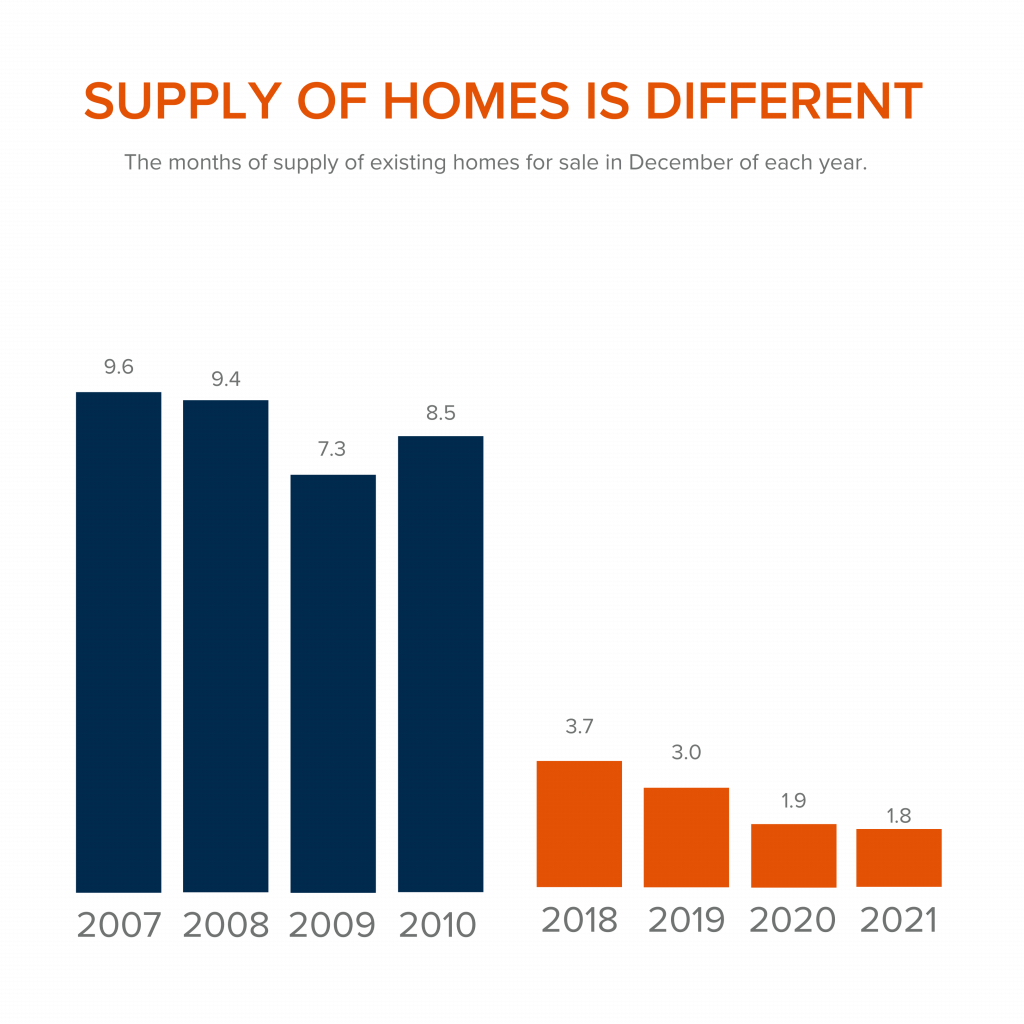
Inventory is drastically different in comparison to last time. Prices are rising because there is a healthy demand for homeownership while at the same time there is a shortage of homes for sale.
At the end of the day,
if you are worried that we are making the same mistakes that led to the housing crash, the graphs above show data and insights to help alleviate your concerns. If you are considering buying or selling and would like to dive deeper into this subject we would be happy to schedule a consult with you. Call us today at 360.675.5953.
7 Tips for New Horse Owners

Horses have been a prominent animal throughout history, dedicated to their human’s side. Many would go as far as to suggest that horses, just as dogs, cats, and other pets can be man’s best friend. Like other pets, horses can contribute to the health, wellbeing, and happiness of their humans so much so that there have been people that contribute overcoming their mental illnesses to using a technique called Equine Horse Therapy. Likewise, many children have found companionship in their horses and have grown to learn valuable life lessons from them.
While we as humans receive so much from these amazing animals, it is equally important that we pay attention to their health, wellbeing, and happiness as well.
If you are new to the equestrian lifestyle here are a couple of tips to keeping them happy:
1) Consistent Exercise:
Horses, just like us need daily exercise to stay healthy and fit. A daily workout helps to reduce your horse’s stress and allows them to release pent-up energy. While it might not look like the typical gym workout, working out with your horse by training can be beneficial for both you and your horse.
2) Keep Vaccinations Current:
Like humans, horses also need vaccinations and it is important that they stay current, or like humans, they can get sick. Having the proper vaccination in a timely manner helps you keep your horse healthy, fit, and happy.
If your horse gets sick, it will take a lot of energy for it to fully recover. Keeping your horse on a vaccinations routine not only will help prevent your horse from getting sick but will also help your horse to recover against the more serious diseases more easily.
To ensure you are providing your horse the best care and keeping regular on its vaccinations, you can ask your vet for a list of vaccines he/she suggests you give to your horse and which ones are most important for your horse to have. If you don’t currently have a vet, click here for a list of ones in our area.
3) Your Horse Needs a Safe and Comfortable Environment:
Here’s one that lies near and dear to our hearts. As real estate agents, we know just how much we as humans want our homes to keep us safe and comfortable. Similarly, your horse not only deserves but needs housing that not only keeps him safe from things like storms and prey but also makes him comfortable. If your horse lives in a barn, provide them a stall and protection. If they live outdoors, they need some way to get out of the sun. Often a run-in shed, or shady trees can give them protection from the elements they need. Additionally, you will need to provide them with a dry walking area, grass, rubber mats, and hoof care.
Not all properties are created equally. When looking at properties, it is important to make sure it is sufficient for your horse and easy for them to maneuver and permitted for horse use. If you need help determining whether or not a property is viable for your equestrian needs reach out to our equestrian advisors here.
4) Good Nutrition:
We know that when we eat junk food, we feel, well like junk. Similarly, your horse requires a diet that can fuel the energy they need to stay fit and healthy. The digestive system of your horse is designed to process large amounts of fibrous foods regularly.
To keep the horse’s digestive health and increase their energy level, you should include grass, hay, and grains in their regular diet along with a lot of fresh CLEAN water. Including traditional mineral blocks into their routine will help your horse maintain an optimal diet. Check out these great places on Whidbey to purchase food for your horse.
5) Your Horse Needs a Dentist Too!
Have you ever been petting your horse when he decides to give you a big lick across your face?! We have too. That’s how we know it is of the utmost importance for your horse to have a dentist too. You should anticipate a checkup about once a year. Like humans, horse teeth grow. However, unlike humans, horse teeth continue to grow and could potentially become damaged by opposing teeth if not properly taken care of. Because their teeth continue to grow it is important for them to be filed regularly to ensure the horse is comfortable when he eats. Could you imagine trying to eat if your teeth hurt you?
Without regular dental check-ups, your horse could develop problems that could lead to more serious problems like colic and choke.
6) Their Hooves:
It is important to take care of your horse’s hooves, by cleaning them and trimming them regularly. Like humans, every horse is different. The growth at which your horses’ hooves grow may be vastly different from that of another’s. However, it is often common for hooves to grow in between 4 to 8 weeks. You can begin trimming them after that.
7) Visit Your Horse Regularly:
The bond between you and your horse should be very strong like the friendship between you and a best friend. You will develop this bond over time by spending adequate time with them. You should expect to visit your horse daily if possible.
But also, like humans, your horse needs equestrian friends too. So get out and make friends with similar interests as both you and your horse.
At the end of the day…
… if you have been considering buying property for you and your horses – let’s connect to determine what is best for all of you. Email us or call us today!
Bird Watching on Whidbey Island
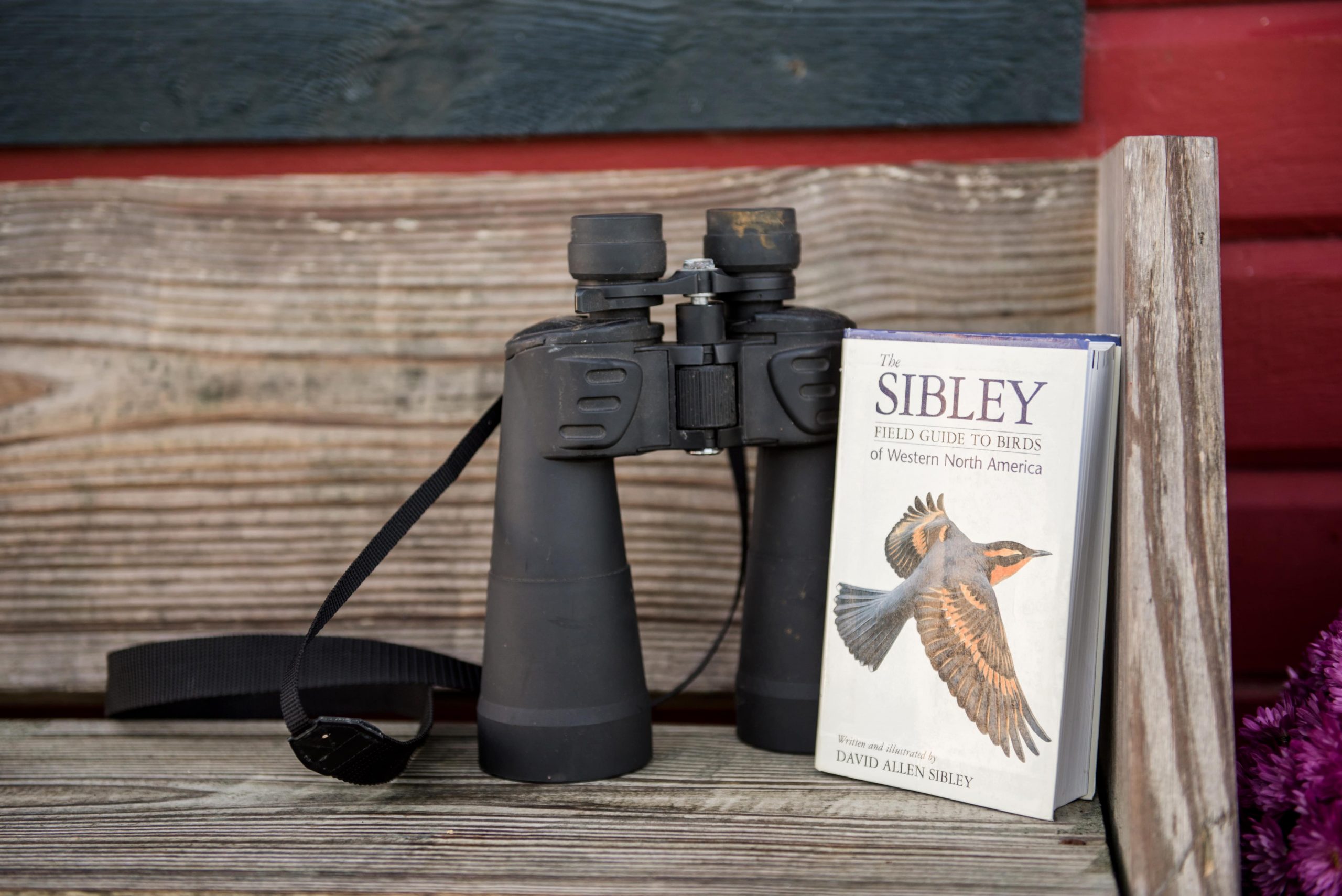

50 miles South of the U.S./Canada border and 25 miles North of Seattle lies Whidbey Island, an incomparable destination for nature lovers and bird enthusiasts. On Whidbey, you can get lost for hours and find yourself mesmerized not only by incredible views but by a breathtaking variety of birds.
Whidbey Boasts 148 miles of winding shoreline, 6 state parks, 4 lakes, hundreds of miles of trail, and a ridiculous variety of habitats from bogs to estuaries to the prairie. It is not surprising then that Whidbey accommodates roughly 250 resident and migrant bird species.

Birdwatchers will declare some of the best times to watch for birds on Whidbey are:
Spring:
Late April through May you can expect to be woken early by the Songbirds singing a pleasant tune.

Fall:
Late July through September It is hard not to miss fat red-breasted Robins filling the apple trees and spot migrant visitors from the north like wigeons, ducks, coots, waterfowl, and red-tailed hawks.

Winter:
November through mid-March is a great time of year to watch for Northern Shrike, Bald Eagles, and other raptor-type birds.

Best places for birdwatching:
If you are just trying to take advantage of easily accessible shoreline almost any time of year works. Some of the best places to watch for shorebirds birds on Whidbey Island are Penn Cove, Keystone Landing, Fort Casey State Park, and Dugualla Bay.
If you don’t live on Whidbey and are coming just for birdwatching be sure to schedule more than one day for viewing. Plan time so you can experience multiple locations, each with its unique features. To better understand all the places you can access the shoreline you really need to buy Getting to the Waters Edge! We sell it at our Windermere offices both in Oak Harbor and Coupeville.
Frequently asked questions:
Some people wonder if there is a time of day that birds are most animated. Typically speaking most birds are bustling around sunrise and sunset but that rule does not apply to all birds. For example, the morning is typically the best time for spotting diurnal species, while nocturnal species are generally spotted in the evening, but it really depends on the bird and the time of year.
Whidbey Island is native to species like Eagles, Northern Harriers, wading birds, loons, grebes, sea ducks, including Harlequin Ducks, dabbling ducks, Black Oystercatchers, Common Yellowthroats, Marsh Wrens, and more. It is also is a temporary home for migrant birds who frequent the island seasonally for the island’s ideal breeding habitats. But do not be fooled. Some birds like robins, hawks, cardinals, finches, sparrows, and more stay here all year but they seem to “return” because they become active again during the spring through fall seasons after they have bundled down in their nests and shelters during the winter.
Additional resources:
To learn more about the birds that can be spotted on Whidbey and a guide for when you will likely catch a glimpse check out this detailed Whidbey Island Bird List created by the Whidbey Audubon Society.
Here are some of our favorite spots on Whidbey to watch for birds let us know your favorite spots in the comments below.
Everything You Need to Know About Riding Bikes on Whidbey Island
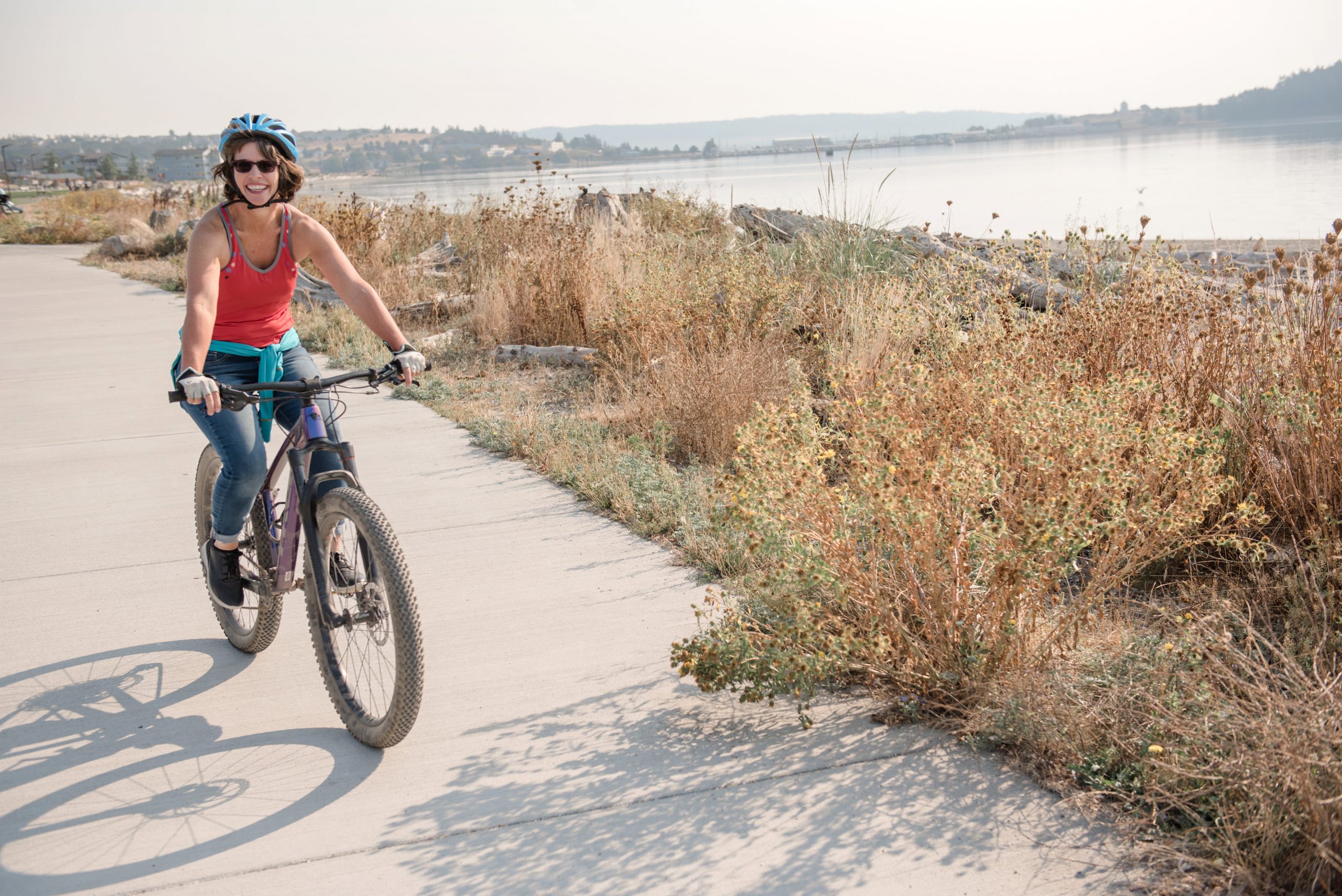
Whether you are a serious road cyclist; an avid mountain biker or just someone who enjoys a scenic bike ride every now and then, Whidbey Island has got you covered. Not only are we home to miles and miles of gorgeous; low-traffic backroads and off-road trails to explore, we also have an active biking community and bike shops that’ll keep you pedaling all year long.
And remember, safety first! You can review Washington State bicycle laws here.

Where to Road Bike on Whidbey Island
If you’re new to road biking on Whidbey Island, this bicycling map of Whidbey Island and Camano Island is an excellent resource to help you get started. This color-coded, detailed map shows cyclists what to expect on different roads, including how many feet of shoulder is available, traffic volume, recommended roads, the difficulty level of any hills,-, and other helpful markers.
Here are a few recommended road bike routes from the bike club to get you started:
North:
https://ridewithgps.com/routes/35094153 (20 miler from the shop, very scenic!)
https://ridewithgps.com/routes/35094160 (40 miler from the shop, scenic and challenging!)
https://ridewithgps.com/routes/35018172 ( The bike clubs Saturday morning route)
Central:
https://ridewithgps.com/routes/35094197
South:
https://ridewithgps.com/routes/35094219
Where to Mountain Bike on Whidbey Island
Trailforks Mountain Biking Trails on Whidbey Island:
If you’re specifically looking for mountain bike-friendly trails, this map is a great place to start. In addition to locations and trail routes, you’ll find information on time estimates, trail conditions, distance, and climb/elevation.
Evergreen Mountain Bike Alliance:
This is another useful resource if you’re searching for mountain bike trails in the Pacific Northwest in general. There are four of Whidbey Island’s mountain biking trail systems highlighted here. You’ll find detailed maps to help you explore Putney Woods/Metcalf Trust Trails, Fort Ebey State Park/Kettles Trails, Hoypus Hill, and Dugwalla State Park.
*For route recommendations and current trail conditions contact Whidbey Island Bicycle Club here.
** For parking on state park property a Discover Pass is required, you can get one here.

Bike Shops on Whidbey Island
If you’re just beginning your biking journey and need to figure out what type of bike to buy, you don’t even have to leave our island to get properly outfitted. The same is true for maintaining your bike—we’ve got experts who are ready to give your bike a tune-up when the time comes.
Skagit Cycle Center:
Skagit Cycle’s Whidbey Island location is in Oak Harbor, and this is your one-stop bike shop on Whidbey. You can buy pretty much all types of bikes here and choose from a huge selection of biking accessories and bike parts, and they also offer an extensive list of services.
Bayview Bicycles:
Located in Langley, Bayview Bicycles offers an impressive selection of e-bikes and bike gear as well as repair services.

How to Get Involved with the Bike Community on Whidbey Island
Whidbey Island Bicycle Club:
If you want to get involved in the local cycling community, meet other local cyclists, volunteer, or attend local group rides then Whidbey Island Bicycle Club, or WIBC is for you WIBC is all about bringing cyclists together to ride and plan rides, advocating for safe cycling routes, developing community cycling events, mountain bike trail stewardship, and supporting community activities that involve cycling. Riders of all levels are welcome to join. WIBC gets together for weekly road and mountain bike rides all yer long- They also have a Facebook page that is frequently updated, so make sure you hit the “like” button if you want to stay in the loop. For more detailed information about the club visit their webpage here.
Tour de Whidbey:
This popular annual summer event on Whidbey Island attracts hundreds of cyclists from all over the Puget Sound region to participate. There are several different routes you can choose from—one route is as short as 10 miles (perfect for families), and the longest route is 162 miles and winds its way around the entire perimeter of Whidbey Island. Tour de Whidbey was canceled in 2020 due to COVID-19, but plans for the 2021 Tour de Whidbey are underway. Find out more here.
Mussels in the Kettles:
This non-competitive mountain bike ride is held annually in conjunction with the Mussel Fest in Coupeville, WA. There are three routes to choose from in varying levels of difficulty that cover most of the Fort Ebey/Kettles trails network. For up-to-date information on the ride, click here, and for the Musselfest click here.
Searching for more fun activities on Whidbey Island? You can continue exploring our community blog here!
Best Places to Whale Watch on Whidbey
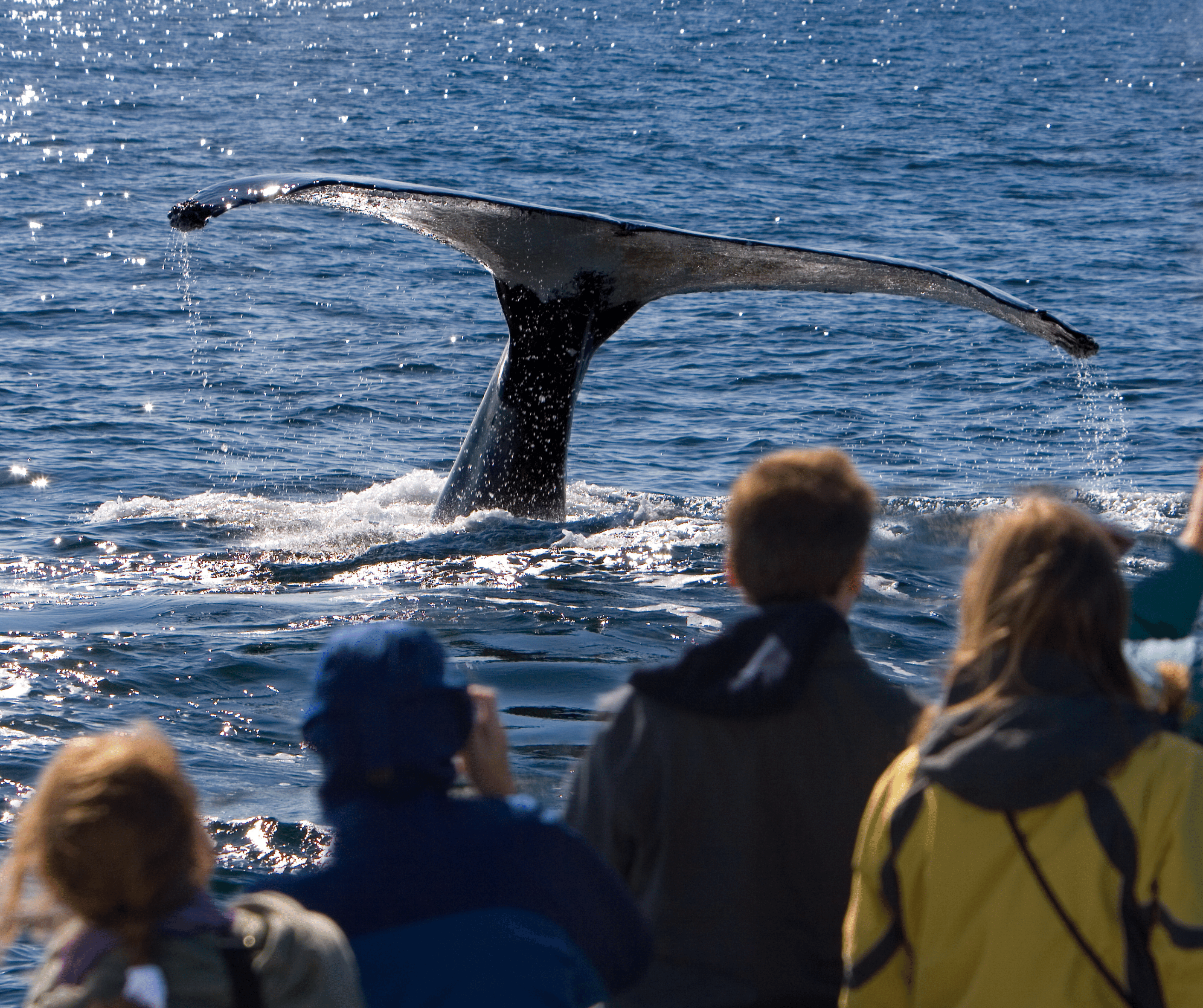
Discover the Best Places to Whale Watch
When it comes to natural wonders, Whidbey Island is unbelievably blessed. With expansive undeveloped areas, nine state parks, and views that take your breath away, it’s hard to imagine it could get any better.
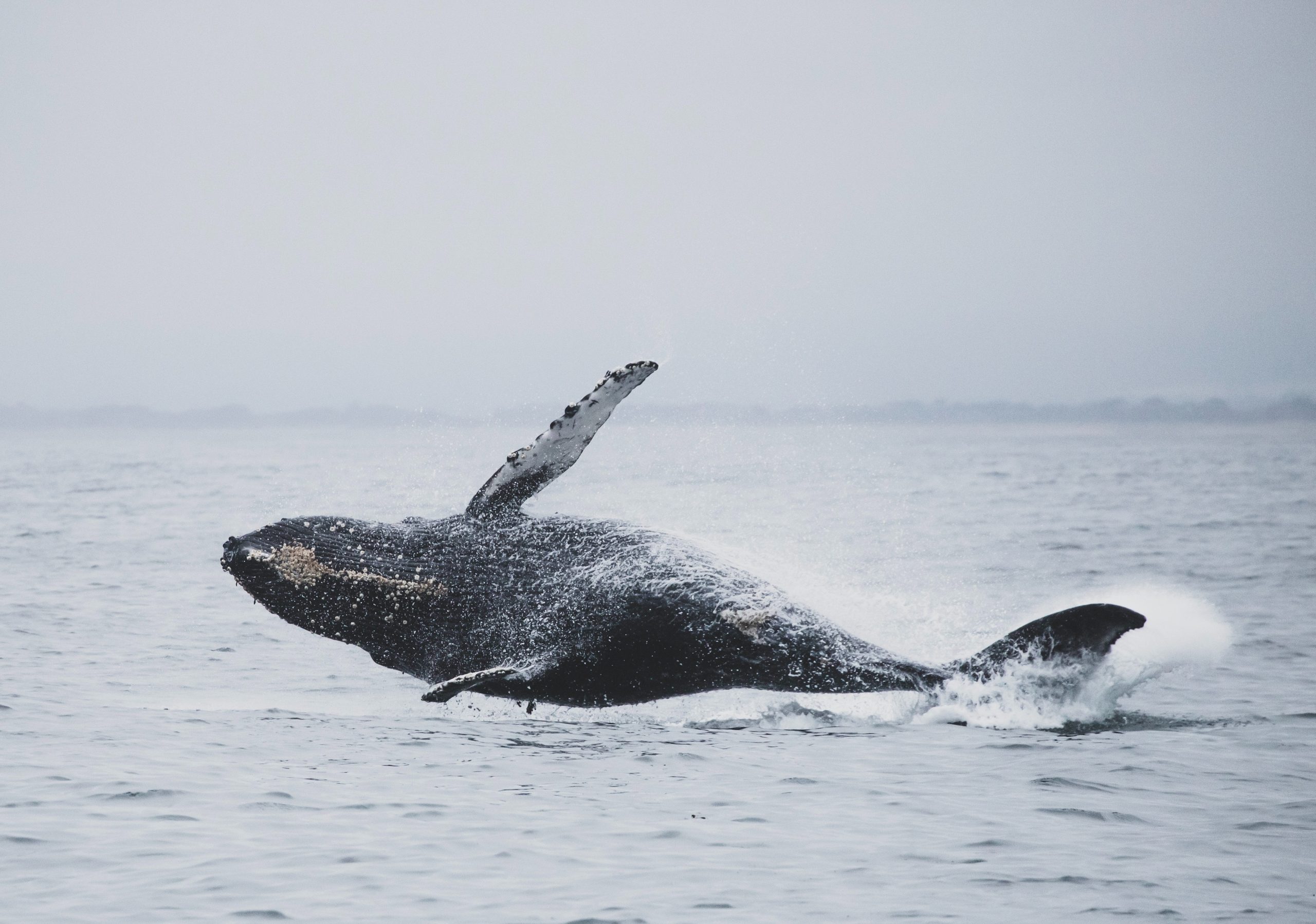
But it does!
In addition to our incredible outdoor opportunities for explorers, we are one of the few places in the world where land-dwellers have an opportunity to get a glimpse of some spectacular mammals of the sea. Puget Sound’s cold and nutrient-rich water makes it the perfect place for whales to roam. Although you could spend the money to board a whale-watching boat and find the mammals out on the water, boats aren’t always required when you’re on Whidbey.
Below are the top 5 places to see whales from land on Whidbey!
West Beach
At the west-most point of Oak Harbor lies a stretch of beach beloved by wanderers and sea life alike. With wide-open views and miles of ocean just off the shore, it’s not hard to see why West Beach is one of the best places to see whales near Whidbey.
Penn Cove
The nutrient-rich water of Penn Cove cultivates a thriving ecosystem for small and large sea life. It’s this sea life in the form of ghost shrimp and fat seals that attracts the attention of gray whales and transient Orca alike. It’s not uncommon for the residents of Penn Cove to see a gray whale’s tail break the surface of the water as they dig in the mudflats for shrimp or a full-on chase between a stealthy Orca and a seal.
Hidden Beach
What this public beach lacks in amenities it makes up for with view and privacy. On a sunny day, beach-goers have the opportunity to see Camano Island sitting peacefully across the Saratoga Passage and – if they come at just the right time – maybe even a whale!
Lagoon Point
Just north of this charming seaside community is a county park boasting nothing more than public access to the Lagoon Point community beach. Luckily access to the beach is really all you need to catch a glimpse of traveling orcas or scavenging grey whales.
Seawall Park
Hidden below the streets of downtown Langley is a quaint little park with beautiful art, well-maintained landscaping, and a spectacular view of the Saratoga Passage. Onlookers often have the wonderful treat of seeing a whale pass or even watch them feed in the massive ghost shrimp beds. If you do, don’t forget to ring the Whale Bell!
Bonus: Your own back porch?
Can you say “waterfront property”? Yes, please! Our beautiful island has many waterfront homes and properties with beautiful views of Puget Sound. How amazing would it be to sip coffee on your own patio while enjoying pods of orca passing by or gray whales feeding on the beach right in front of you? If this sounds like your dream, give us a call today!
Now, remember, if you do see a whale you should report it to the Orca Network! Reporting sightings to the Orca Network helps with scientific efforts and helps other whale watchers like yourself!
If you liked this, you might also like:
Get the Buck Out of My Yard

Have you ever been standing there admiring your gardens when a deer walks in and decides it is time for lunch? So have we.

They are the wild and majestic creatures of Whidbey Island, often found in the peaceful pastures of Ebey’s Landing or beneath the cooling tree shade of the state parks. They are elegant, graceful, mesmerizing… and frankly a pain in the arbor.
Oh deer, oh deer, oh deer.

Don’t get us wrong, we LOVE our Whidbey Island deer and are grateful to live in a place where wildlife feels welcomed. However, if you’ve been working hard cultivating that garden all year long, the last thing you are interested in is a handful of fauna munching on the fruit of your labor. To top it off, deer can carry ticks with Lyme disease which can be extremely harmful to both humans and their dogs.
Sorry Bambi, but no one messes with mans’ best friend.
We’ve done a little research and decided to give you a hand with those pretty, yet pesky visitors.
5 pro-tips to get the grazers out of your garden.

- Cut ‘em Off! – It might seem like the most obvious solution, but fences are always a great first step to keeping out unwanted guests. Although deer are great jumpers, the additional effort required might just be enough of a deterrent. < We’re all a little lazy.
- Don’t Plant Tasty Treats – Deer LOVE plants rich in nutrients, moisture, and basically anything else your doctor said you should eat more of. This includes almost all produce plants as well as leafy ivy and bright, water-filled flora. Instead of these, try planting pungent flowers like lavender with greenery that is thorny, hairy, or prickly. You can also use these less desirable plants as a natural barrier for the tastier ones. If all deer see and smell is lambs’ ear and snapdragons, odds are they won’t investigate much further.
- Let Rover Out More – Chances are your dog is like most others and DOES NOT see grazing deer as welcome guests. Barking dogs are a big deterrent for deer. Who wants to eat with someone yelling at you? Eventually, the deer will likely decide your home isn’t a safe place to eat and won’t return.
- Shine a Light on the Situation – Deer are more skittish than the commitment-phobe you dated in college. Installing motion-sensitive floodlights can often leave a deer stunned and anxious to get away as fast as they can.
- Live a Little! – Although we might find them beautiful and nice to look at, deer aren’t that excited about us. Chances are if a deer sees you out and about in the yard they will simply turn around and find someone else’s garden to plunder. So, get outside more! See this as an opportunity to re-imagine your yard and incorporate more outside living space. Your health and your hydrangeas will thank you.
You might also like:
Fourth of July Celebration on Whidbey Island

Fourth of July Celebrations on Whidbey Island
Carnivals, parades, BBQ’s, music, and of course huge firework shows make an incredible Fourth of July celebration on Whidbey Island. There are small events up and down the island but the two hot spots for firework shows and lots of activity are Oak Harbor and Freeland.



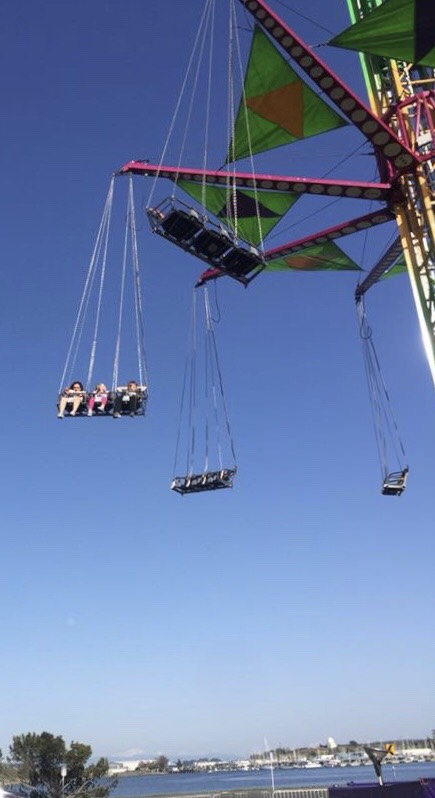
Freeland Celebrations:
The celebration begins in Freeland on July 3rd with their annual “Celebrate America” event at Freeland Park. Starting mid-afternoon there will be face painting, bounce houses, music, and live entertainment for you to enjoy! This year the event will feature a magic show, circus tricks, martial arts demonstrations, a dance team, and a Neil Diamond tribute band. At the end of the day, the party will go out with a bang with the largest fireworks show on Whidbey Island beginning around 10:20 pm. For a full schedule of events click here! https://whidbeycamanoislands.com/event/celebrate-america-2018/.
Oak Harbor Celebrations:
In Oak Harbor, Independence Day festivities take over the whole town! The carnival will be open June 29th through July 4th with rides, classic carnival food, games, and so much more! You can purchase your carnival tickets ahead of time here ( https://oakharborchamber.chambermaster.com/eventregistration/register/7591 ) to avoid long lines at the event. On July 4th the party continues with a day that is jam-packed with activities. It all starts with the annual Rotary Pancake Breakfast, grand parade down Bayshore Drive, and throughout the day you will be able to check out the street fair on Pioneer as well as enjoy live music at Smith Park. Finally, to wrap up an eventful day, you won’t want to miss the firework show that starts at dark. (Rumor has it that it will be the tallest show ever!)
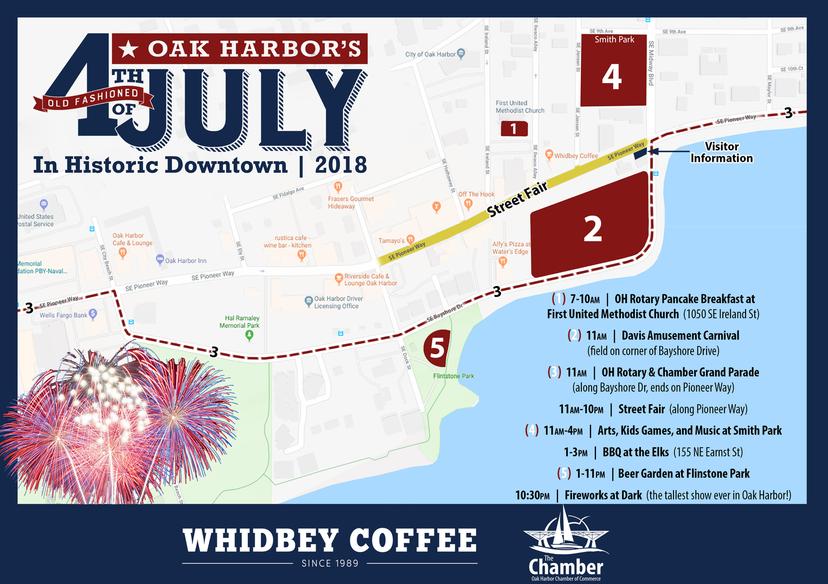
We can’t wait to take part in the fun this year! If this is your first year experiencing the bustle to take place on the island, you won’t be disappointed! If you have been, we want to know what your favorite part is!
You might also be interested in:
#mc_embed_signup{background:#fff; clear:left; font:14px Helvetica,Arial,sans-serif; width:100%;}
/* Add your own MailChimp form style overrides in your site stylesheet or in this style block.
We recommend moving this block and the preceding CSS link to the HEAD of your HTML file. */

 Facebook
Facebook
 X
X
 Pinterest
Pinterest
 Copy Link
Copy Link







